|
One day in 2005, the daughter of French Jewish artist Linda Ellia brought home a book that had turned up in a friend's house, a new French translation of Hitler's Mein Kampf. Ellia held the heavy, monstrous book in her hands and the shock of it, the emotions tearing through her brought up some big questions. What now? What to do with the "Nazi Bible"?
"What should we do with such a book?" Simone Veil, Auschwitz survivor, former French Minister of Health and 16th President of the European Parliament, asked about Mein Kampf. "Ban it? Some would still pass it around on the sly. Forget it? It would be an insult to the millions who died because of it. Burn it? It would be resorting to the methods used by the Nazis …"
Linda Ellia began answering these questions by cutting out pages, marking and overwriting and erasing them with paint. After a few dozen pages taken in hand in this way she was struck by the thought: how about others? How about inviting others to engage with and deconstruct/ reconstruct the rest of the 600 pages?
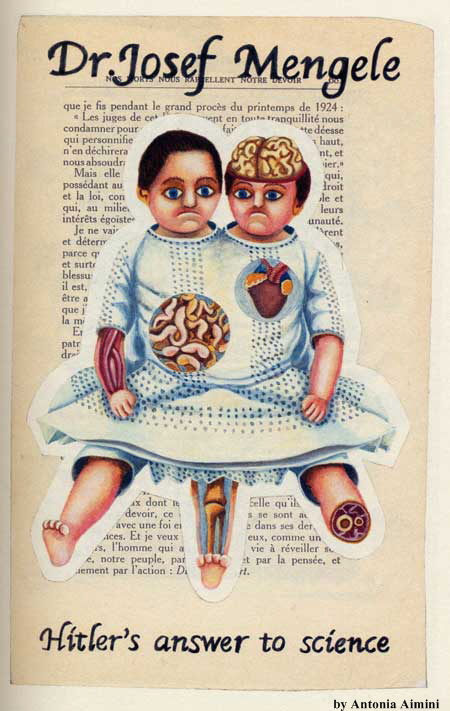 |
It took her three years to find the others. She would not just get her artist friends and friends of friends involved. "I stopped perfect strangers. I would go into a cafĂ©, and based solely on intution, I would approach people that I thought could create an emotional, artistic page… A chain reaction was formed globally and suddenly I had amazing messengers from all around the world helping me. The project became almost a performance – proof that it is possible to take up arms against trauma." This sounds much easier than it was. In an interview with the San Francisco Chronicle, the artist told about the slow, painful process, about the discouragement by her art professors who advised her to go back to her paints; about rejection, hostility and racism. She even met with criticism from Ashkenazi Jews because a Sephardic Jew (born in Tunesia) was taking on "their" history. Ellia called her action "Notre Combat" (Our Struggle) – an allusion to the French resistance movement "Combat". It strongly reminded me of the German project of the "Stumbling Stones" (Stolpersteine) that also met with suspicion and indignation at first (see archives) before growing into a big movement.
In the end, Ellia managed to find an "author" for every single page — Jews and Palestinians, Moslems and Christians, Americans and Germans — a vast community driven by resistance and healing through art. The result is a book of the same title, Notre Combat (Our Struggle) — 600 pages of highly emotional, political, explosive art – a book, to state the obvious, like no other. The pages don't follow the original pagination. Rather, they follow the random way Ellia handed them out and received them back in the mail – they are composed in a purely intuitive, artistic process of book design. Her book constitutes a highly ironic collective master piece of art based on the author who was a notorious failure as an artist. All the contributors are named in the book; there are famous names among them (artists like Kiki Picasso or fashion designer Christian Lacroix) but most pages are not signed and not attributed to a name. Notre Combat was published in 2007 by the Editions Seuil, a major art publisher in France, with a foreword by Simone Veil.
Veil had become the "godmother" to what she called "Linda Ellia's luminous intuition" to "turn this book into a memory vector." Her words are also the motto for the exposition at the Contemporary Jewish Museum of San Francisco that shows 450 of the original pages of Notre Combat (Our Struggle) until June 8, 2010. Surprisingly, the work has been only shown once before, in Switzerland. Even more surprisingly, there are no plans yet for other shows.
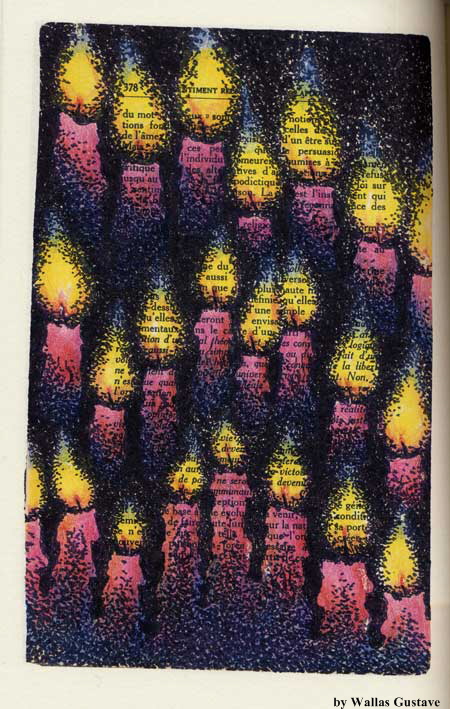
Many people invited by Ellia or volunteering through word of mouth were reluctant to even touch a single page of Mein Kampf, to say nothing of taking in "their" page, engaging with Hitler's ranting and raving and formulating their response on that same page. But when the engagement took place, the rage and outrage sometimes proved unstoppable. A reluctant homeless artist, Gustav Wallas, who spent his days in a Paris café and his nights in a squat, ended up taking on 20 pages and did such powerful work that Ellia gave him his own wall space in the exhibition. An example of the simplicity and emotional impact of Wallas's work are the rows of candles that cover one of Hitler's pages: at first glance they can look like illuminated tears before revealing themselves as Shabbes licht, the Sabbath lights of Jewish tradition, replacing darkness and evil with a glow of hope.
The darkness and light of memory, of death and transfiguration are echoed in many extraordinary ways on these pages. Painters and illustrators, poets and writers, cartoonists and graffiti artists, children and designers: page after page the originality and artistic urgency of the enterprise are stunning. Page after page, Hitler's memoir-manifesto is buried under ash, erased with Chlorine, stamped out with anti-Nazi seals, plastified and molded into three-dimensional death heads, tarred and feathered (by 26-year-old San Francisco native Robin Mergerin), bedded into a coffin as a shroud that holds a Hitler doll, torn, crumpled, singed with fire, stapled into illegibility, cut into shreds, pierced with a bloodied pen, wiped out with red ink, sliced up and sewn back into incoherence, stitched with red thread as if cut with a surgeoen's knife, veiled by bits of prayer shawls, glued over with the names of victims, crossed out with barbed wire.
One participant has censured a page with Hitler's chapter title "The Importance of the Word" by halving the page: word by word the left half is blacked out, the other half blocked by white-out: a muted, senseless world devided in black and white. Linda Ellia herself has "encaged" a page entitled "Years of Studies and Sufferings in Vienna" with a dense set of wires like a poisonous object that is best not touched. The hard-cover box that encases the paperback book carries this image of danger.
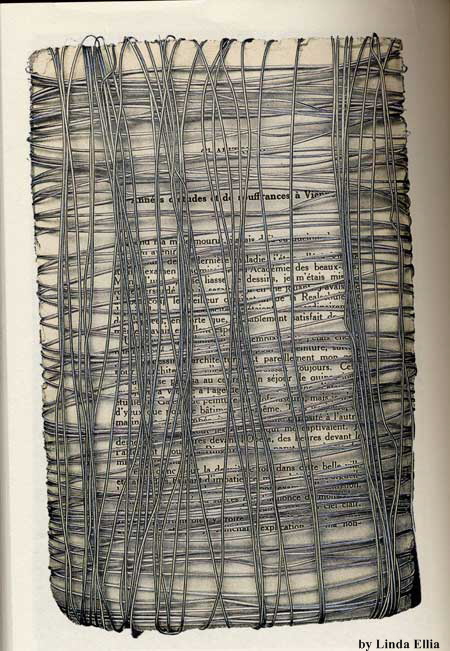
The great majority of works reflects on or uses imagery of the Holocaust — ghost-like bodies, skeletons, mass graves, trains and rails. Swastika windmills rise on a blood-red sky of text. One participant has glued an original yellow star, the Judenstar, over the page; another has sewn on a twisted, tortured heart with a horizontal split that reveals one sentence of the original page, "I thought my heart would burst". Some contributions are more or less abstract paintings, shadowy scenes of impending doom, the fog of history —"nuit et brouillard." Others employ a socialist-realist style: four strong fists (with hints of the Allied flags on their wrists) tear apart the Swastika over their page. One participant mixes postal stamps from Nazi Germany with old stamps from Eastern Germany's post-war communist dictatorship; another uses war-time food stamps from the Reich and leaves five words: "the fall of a body" visible in the center. Another artist lays a half-transparent Metro map — "Map for the construction of a dictatorship" over the page, and the stations are now named after the Final Solution – Ignorance, Treason, Corpses, Hunger, Hatred, Humiliation, Trauma, Gas… Another participant's ghostly map traces the location of the camps over the page; another pastes the words into blocks forming the barracks of Auschwitz.
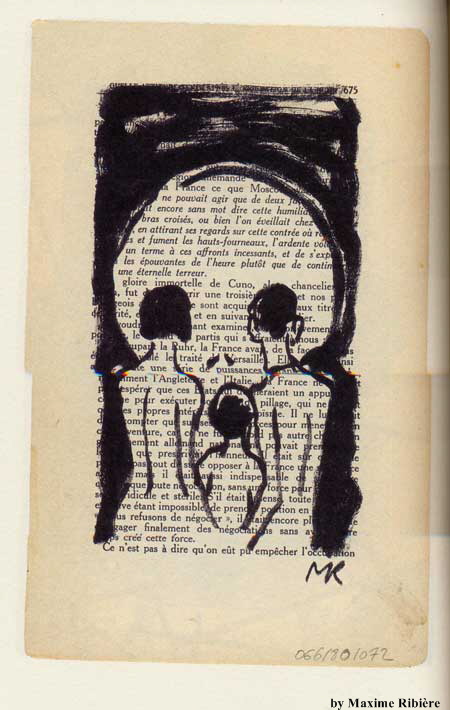
There are of course many disturbing Hitler portraits. One of them is a brilliantly realistic painting with the added "hologram" effect of a death-head and the last line of the original page at the bottom: "One never knows what can hide behind such individuals." Among the grotesque caricatures of the FĂĽhrer, one illustrator seats him behind bars in his prison cell in Bavaria, furiously scribbling the words that appear on the page behind him: a deranged, frightfully demented character.
Notre Combat offers countless fascinating ways of telling the truth about Mein Kampf, disfiguring and refiguring the text, or rendering it secondary, unreadable, irrelevant even. Seeing 450 originals in three dimensions and full, vivid color at the exhibition is a unique experience, whereas the book contains all 6oo pages and does a very good job of it. One page has every single letter turned into a tiny skull; another drowns each letter in a droplet of blood-like lacquer paint. One artist has painstakingly drawn every letter into a tiny human being: the crowd of women, men and children stands as if in endless lines across the page. The chapter title on top of this page reads: "Concentration On One Single Task" and two bits of text appear among the hundreds of people lined up here: "the importance of this struggle," and "life or death." The space below the text is blackened by little stick figures falling and fallen to their death in a heap. Another page is "walled in" with beige paper, leaving only one wall space open for one original sentence of ludicrous hypocrisy and grandiosity: "By defending myself against the Jew I struggle to defend the work of the Lord." One page has almost vanished into non-existence behind a careful layer of gauze; all that transpires are two words: "would disappear." Another page has been partly painted over by a white teddybaer with a sad smile and a thought-bubble saying, "I couldn't go with her on the train, she usually takes me with her on vacation…"
A number of pages replaces the text entirely with new writing — personal narratives, poems, manifestos of resistance and comments on the degeneration of German culture. One stunning replacement quotes the hate-filled everyday commands and expletions of a typical German father's authoritarian voice, signed "Hell". An equally stunning text addition is hand-written over the title page of this new translation. Around the author's name, above the title Mon Combat (Nouvelles Editions Latines) one reads a statement of the barbaric loss of culture: "Tage der Wonne/ Schenktest Du uns, / Tage des GlĂĽcks./ Schenk uns, bevor wir verarmen, / den Tod." (Days of bliss /You gave us, / Days of happiness./ Grant us, before we are diminished/ our death.) It is written in German and French, adding, "Johann Wolfgang von Goethe 1749-1832. Citation written by my grand-father Hans Deinhardt and his son Peter in spring 1934, in an Alpine refuge, before their voluntary leap to death. His grand-daughter."
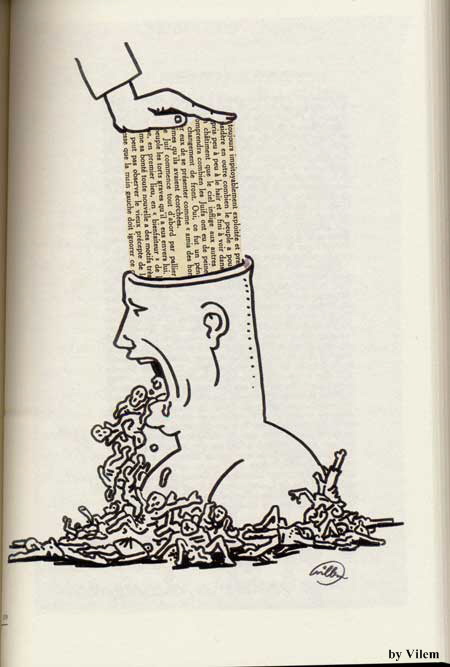
On the whole, there is still enough text of Mein Kampf left (if you read French) to appreciate the rabid-dog obsessions of the original author. The unreserved violence and emotionality of the reactions in Notre Combat, outrage and caricature as well as grief, are shocking and deeply satisfying. Some pages are left almost untouched. One of them shines a gruesome light on the page by placing four pairs of eye-glasses – from the mountains of concentration camp remains — on top of it. A similar one, by Linda Ellia, is the page of Hitler's "Conclusion" in Mein Kampf. She has simply attached a large gold tooth in the center. Her own last book page hangs a blond, shiny lock of hair from the top with a rubber band, separating the words in the headline – La ruine (ruin) on the left, IdĂ©e de Chef (chief idea) on the right.
Amazingly, there are pages of humor (black humor, Jewish humor) and hope as well. Two pages have been worked over with a hole-puncher, the resulting confetti are gathered in little plastic bags, titled "My Kampfetti". Another page is rolled into a cigar with a golden band revealing the brand: "Churchill". The FĂĽhrer stands behind a lectern with a mic: "And I would also like to thank the entire team without whom all this wouldn't have been possible." A street sweeper sweeps the letters off the page as the dirty mess of history.
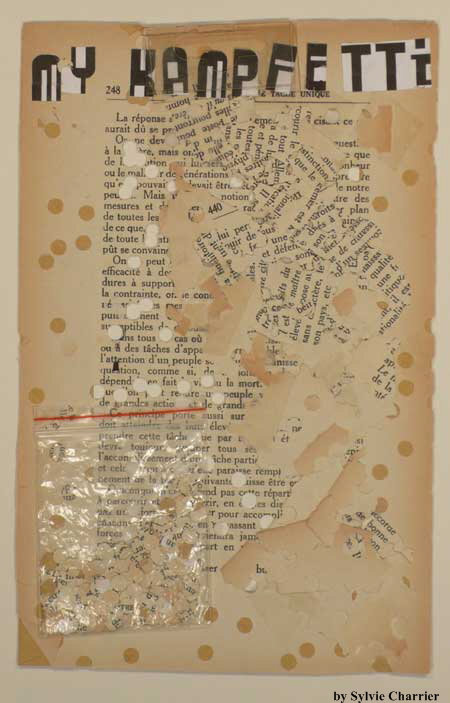
Among the messages of hope, Susan Thacker, a Jewish artist living in Carmel, California, has painted ten praying minyans onto the text – the requisite 10 Orthodox Jewish men needed for morning prayers, as viewed from above. "Someone called it gods-eye view," she said. "The point is to view life from a different perspective." One could also see the page as other-worldly eyes looking back at the beholder – for example the "ten righteous men" of the Bible whom Abraham couldn't find.
Linda Ellia's own work stands out with a particular radiance. She drew a frame around one page of text and blacked it out in a way that left tiny white flecks – a whole night window filled with improbable, almost sparkling stars. Her front book cover shows long strips of text bundled like a sheaf of wheat or grass, tied together with another strip of text, all in the egg-shell patina of the book pages, a mystery begging for the creative interpretation of the viewer. What does it mean? Is the book that at first weighed on her like the weight of the entire Holocaust so fragile as to be blown away with a single breath of wind? Her back cover is also an artistic puzzle. It is a completely blackened page, and this time the brush strokes have left out letter spaces that look both like whip-marks and like tears.
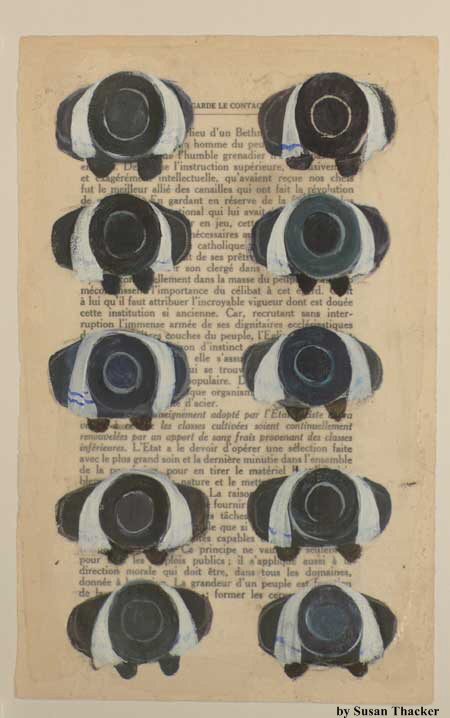
"Today's tyrants are not called Hitler and the victims are not invevitably Jews," Ellia said in conclusion to her project. "Our struggle is evidence of an emotion felt by artists, writers, poets, musicians, film makers, journalists, victims, Jews, Palestinians, Lebanese, Tibetans, Yemenites, students, the anonymous. It is a message of hope for all those dealing with racism, persecution and violence – that art conceived of as an inclusive act can be a powerful and emotional response to collective trauma."
Part of the exhibition that lines the walls of several rooms in the museum is a long blackboard inviting reactions and comments from visitors. The first time I went I got permission to photograph a spontaneous drawing by a visitor that must have been exactly what Ellia and the museum had in mind – a response in art to the unforgettable horror of the Shoah: a drawing of a person expiring in a gas chamber that could have been a part of Ellia's book. The next time I went, it was wiped off, replaced by comments like "Powerful" and "Never forget."
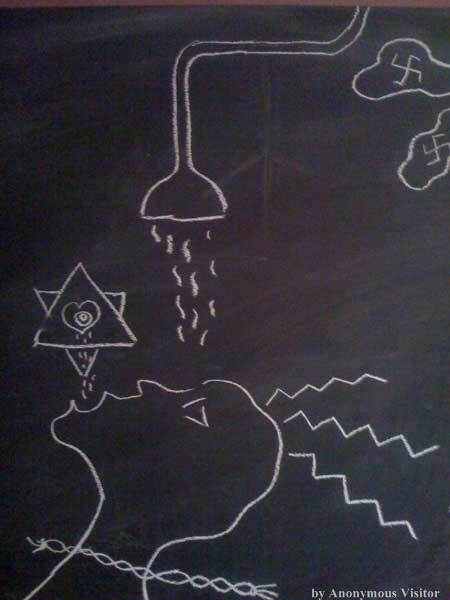
The museum also provides a touching documentary film on Linda Ellia and Notre Combat, and the gift shop sells her book for $65. After much discussion among curators, Ellia, scholars and community members, the decision was made to put one ominous historic copy of Mein Kampf on show in a glass case, under surveillance around the clock. It is a pompous presentation copy, a huge, bible-like monster of a book that once belonged to Hermann Göring and was donated to the Holocaust Center of Northern California.
An adjoining room offers related literature and information about the status of Hitler's memoir-manifesto in today's book market. According to this research, Mein Kampf is either forbidden or (hold on to your seat) a bestseller: forbidden in Germany, Austria, Israel, Brazil, Mexico and the Netherlands, for example; freely available in the USA, Canada, Sweden and France; sold as a Manga comic strip in Japan; popular in India; a recent bestseller in Turkey. The copyright belongs to the German state of Bavaria and is going to expire in 2015.
Images Courtesy of the Contemporary Jewish Museum
Cover Photo - Linda Ellia with two pages from Notre Combat by Katharina Vonsaalfeld (left) and Alexandre d'Huy (right)
|
|



